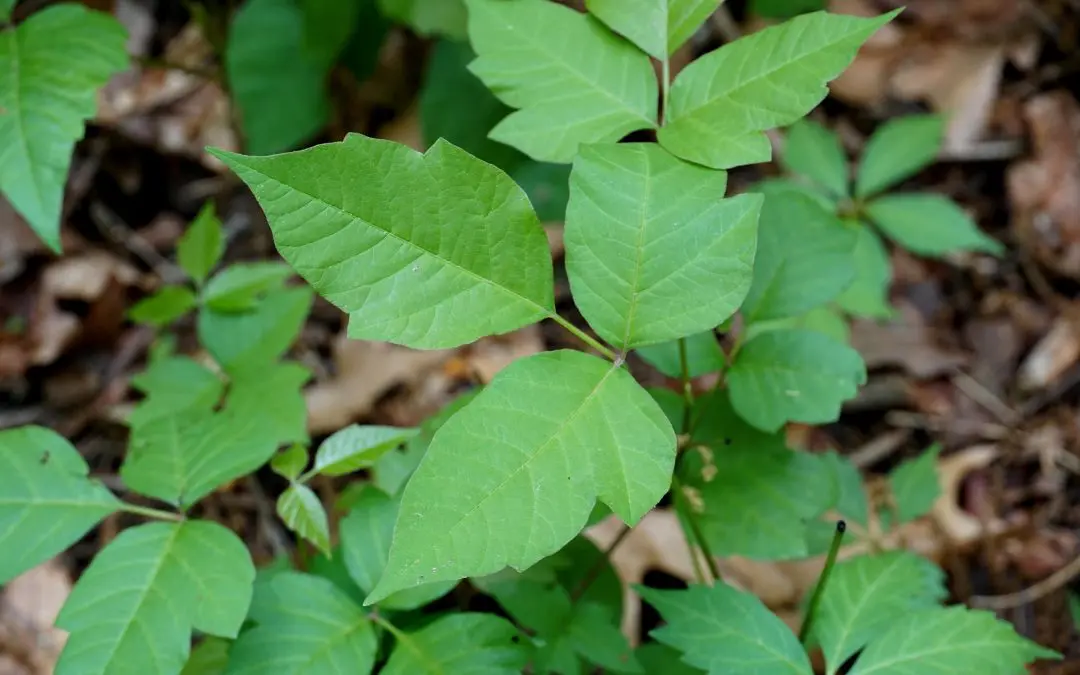You’ve probably seen it growing by the fence or lurking at the edge of the woods. This plant is notorious for making people itchy and sometimes downright miserable. Being able to identify and remove poison ivy from your property will help keep you and your family safe while enjoying your outdoor spaces.
What Does Poison Ivy Look Like?
Poison ivy is known for its “leaves of three.” Look closely: each leaf stem has three distinct leaflets. These leaflets vary in shape – sometimes they’re smooth along the edge, other times they have a few notches or lobes, like a tiny oak leaf. They can be shiny or dull, too, and the color changes with the seasons. Fresh spring growth might have a reddish tint, mature summer leaves are a vibrant green, and in the fall, they turn beautiful shades of yellow, orange, or red before dropping.
Another key identifier is the plant’s growth habit. It’s very adaptable! Sometimes it grows as a low-spreading plant on the ground, like a groundcover. Or, it might take the form of a standalone shrub. But its most recognizable form is as a vine, climbing up trees, walls, or fences. These vines get thick and woody over time, sometimes developing little rootlets that cling to surfaces. In late summer and fall, whitish-yellow berries appear, which often persist into winter.
It’s the invisible oil, called urushiol, found on all parts of the poison ivy plant—leaves, stems, and roots—that causes reactions in many people. Even dead plants retain this oil for a surprisingly long time.
Tackling the Challenge: Careful Removal
You’ve spotted poison ivy and decided it needs to go. Dealing with it requires caution and preparation. The most important thing is to protect your skin from the oil. Wear long sleeves, long pants tucked into socks, sturdy gloves (vinyl or nitrile over leather is often recommended, as the oil can soak into fabric and leather), and eye protection.
Manual removal is certainly an option, especially for smaller patches or younger plants. The best time to do this is when the soil is moist, making pulling up the root system easier. Try to get as much of the root as possible, as it can resprout from root fragments. Carefully place the pulled plants into sturdy plastic bags. Avoid letting plant parts brush against your skin or clothes.
Herbicides can be effective for larger infestations or stubborn vines. Products containing glyphosate or triclopyr are commonly used. It’s best to apply these when the plant is actively growing, usually in late spring or summer. Follow the product instructions carefully and be mindful of surrounding desirable plants. The plant might put up a bit of a fight, requiring repeat applications.
How To Remove Poison Ivy
Getting rid of the pulled-up plant material is just as important as the removal itself. Never burn poison ivy! The urushiol becomes airborne in the smoke and can cause severe respiratory irritation. The safest method is to bag the plant material securely in heavy-duty plastic bags and dispose of it according to your local waste regulations.
After handling the plant, it’s important to clean everything that might have come into contact with the oil – gloves, tools, and clothing. Washing with soap and cold water is recommended.
Dealing with this plant yourself is doable as long as you take the right precautions. Cover yourself up and get rid of it so it won’t pose risks to your family.
FAQs
What should I do if I think I’ve touched poison ivy?
Wash the affected skin area thoroughly as soon as possible with soap and cool water. Specialized poison ivy cleansers also help remove the urushiol oil.
How long does the urushiol oil remain active on surfaces like tools or clothing?
The oil can remain potent for a surprisingly long time, potentially for months or even years, especially in dry conditions. Proper cleaning of tools and clothing is essential.
Can my pet get poison ivy and then transfer it to me?
While most pets are not sensitive to urushiol, the oil can stick to their fur and be transferred to human skin, causing a reaction. If your pet has been in an area with poison ivy, it’s a good idea to wash them carefully while wearing gloves.
When should I consider calling a professional for poison ivy removal?
For large infestations, climbing vines on valuable trees or structures, or if you are highly sensitive to poison ivy, hiring a professional landscaper or arborist experienced in its removal is a wise and safer option.
Esham Inspections provides home inspection services, mold inspections, and water testing to Maryland and Delaware. Contact us to schedule an appointment.

